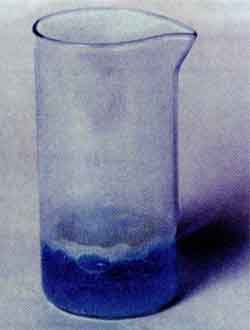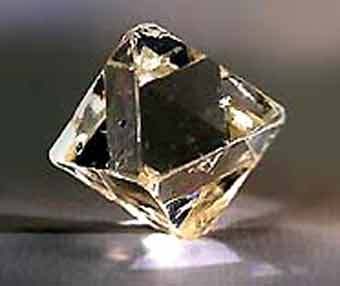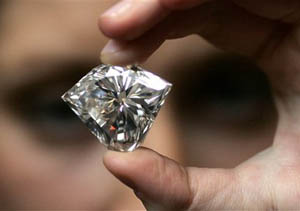
Liquid oxygen

Carbon, graphite

Carbon - diamond rough

Carbon - diamond

Diamond
Oxygen O2. Oxygen is the most abundant element on Earth and is 46% by weight of all available chemical elements. Second place goes to silicon (24%), then iron, calcium and others. Oxygen colorless and has no smell. Liquid oxygen is a liquid of bluish color (the liquefaction temperature of -183°C). Liquid oxygen freezes at a temperature of -219 °С.
Qxygen is gas is slightly heavier than air. With electrical discharges form the ozone molecule, O3 – blue gas. Especially a large amount of ozone is produced during thunderstorms. You probably feel a pleasant, fresh smell outside after a heavy rain storm. This is ozone. By itself in small quantities it is not poisonous, even useful for breathing. But concentrated ozone is quite harmful.
Consider some of chemical properties of oxygen. As a chemical element oxygen is a strong oxidant. A mixture of 2 volumes of hydrogen and one volume of oxygen are so-called "detonating gas". A mixture of these gases especially explosive at increased temperature. Oxygen itself is explosive: in air at high temperature, it explodes and forms the water vapor.
As a chemical element oxygen easily oxidizes metals. Some of them interact directly at room temperature (mostly alkali metals). Some pure metals form a dense protective oxide film at its surface (some of them are aluminum and copper), due to they are not destroyed. Also to these metals are magnesium, zinc and especially gold and platinum which are resistant even to strong acids (sulfuric acid, nitric acid, hydrochloric acid, perchloric acid HClO4).
If entry heated metal into the vessel, that contains the gas oxygen, the metal lights up quickly and brightly and forms the oxide.
Oxygen gas when heated, reacts with metals, oxidizing them to oxides.
Often reactions with oxygen accompanied with the release of large amounts of heat and light energy. A typical example is the combustion reaction. For example, all organic substances (except by-products of the reaction: sulfur S, chlorine Cl2, nitrogen N) burn and form carbon dioxide CO2 and water H2O.
Carbon C: the simplest and the most known carbon is graphite, black, with metallic luster, is quite fragile. With graphite can be got artificial diamond. Diamond is one of the most solid and refractory (t(melt) >4000 °C) substances. At the same time, the diamond is brittle: it is relatively easy to split apart. For that jewelers use a knife on which strike a hammer. That form of carbon - the diamond has very high thermal conductivity — conduct heat better than many pure metals (4 times better than copper). At the same time, diamond does not conduct electricity. Often the diamond has a particular hue. Known diamonds colors: orange, blue, pink, yellow, brown, milky-white, blue, green, gray and even black. The color of a diamond is due to defects in their crystal structure, and with the partial substitution of carbon atoms with the boron atoms, nitrogen and even aluminum atoms. Grey and black coloration of diamonds is caused by inclusions of graphite. Graphite is the most stable at room temperature allotropic modification of carbon. All the diamonds theoretically must be turn to graphite, but with reaction goes only then the temperatures 1000 °C, and at 2000 °C it happens almost instantly. However, from a practical point, the greater interest is the reverse process — the transformation of graphite into diamond. This becomes possible at a temperature of about 3000 °C and a pressure of 3•106 ATM. Unfortunately, the diamonds that can be got from graphite, is usually very small and of low quality. They can be used only for technical purposes. In nature diamonds are can be found as inclusions in kimberlite pipes — a funnel-shaped crust, filled with kimberlite ore. Then destruction (weathering) of the tubes the diamonds become placers. You can find th diamond in nature in the form of a shapeless mass, not transparent. Diamond is the pure carbon - another form of carbon with excellent structure from graphite, very hard (hardness of diamond is adopted in the technical literature as one unit).
We know, that upon heating of substances its go from the solid state into the liquid. But for chemical element - carbon this version is erroneous. If you heat the carbon up to 3500°C, we see that it, bypassing the liquid phase, passes into the gaseous state (sublimate).
Carbon has the ability to absorb like a sponge the different colors and smells.For example, if in the ink solution put a piece of coal, we may soon notice a sufficient difference between the color of the initial solution and of the solution where a piece of coal. It is known that this method is used to neutralize various poisons in the our body. In pharmacies you can find carbon in the form of tablets with the name "activated carbon" is the ordinary carbon, just cleaned and is suitable for us. A huge number of carbon found in space, on the big asteroids, in the grounds of the planets, in the composition of comets. Carbon isotopes are the result of fusion and decay of other chemical elements.
Consider some of chemical properties of carbon
Chemical element carbon an excellent reducing agent. At high temperature, with it is synthesize a huge number of organic compounds (much more than inorganic).In the industry with the help of carbon get some pure metals, restoring them from their oxides. An example is the restoration of pure iron from its oxide with the carbon then it mixture to heat.
Depending on how much oxygen is supplied to the oxidation of carbon (burning of carbon), produces a variety of carbon oxides.
The combustion of carbon in the atmosphere, slightly enriched with oxygen, it forms carbon monoxide (not color and not smell), but having the ability suffocating.
Carbon monoxide - CO has greater chemical activity. If it enters the our body it can cause dizziness, as it takes the oxygen from the blood, turning into a carbon dioxide CO2. For the same reason (the interaction with oxygen and formation of carbon dioxide) to do fires in an enclosed space is not recommended. Even ordinary familiar carbon dioxide CO2 at a concentration of 10% causes pain and suffocation.
Under the action of solar light carbon dioxide CO can react with chlorine, forming a very toxic phosgene gas COCl2.
When an electric discharge between graphite electrodes in a nitrogen atmosphere forms a very toxic gas cyan CN.
All organic substansec have chemical element carbon. This the main principle of defining them.